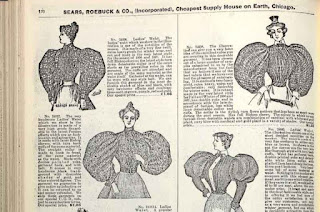 |
| The seamstress heroine of my 2nd novel was too fashionable to fall for this trend |
Both posts connect to how the characters in my Persimmon Hollow novels would have been familiar with Sears catalogs. I've just reprinted Books 1 and 2 with a new publisher and new covers that fit the theme of Book 3's cover.
The novels are set in the late 1800s. Fast fashion as we know it today didn't exist in 1896 pioneer Florida. Yes, a person could buy ready-to-wear clothing in stores and from catalogs. But each item was purchased with an eye toward longevity. Most women and probably a lot of men knew how to sew and make garments. They spent quite a bit of time doing so. Far more than today.
The heroine of my second novel is a seamstress named Josefa. She perfects her craft through an apprenticeship with the town dressmaker. Any author will tell you their characters seem like real people to them. I'm no exception. I can imagine Josefa poring over the fabric selections of the Sears catalog.
The section wasn't named "Fabric." No, it was the Dress Goods Department. It started on page 136, right after a page selling cheese box machines and creamery butter tubs.
Dress Goods depicted “all the newest and choicest products of foreign and domestic looms for the fall and winter season of 1897.” That wasn't all. There also was material touted as year-round fabric and a promise that “all the popular new up-to-date fancy brocades, Jacquards, two toned effects” were always in stock in great variety.
The prices almost made me swoon. A two-color diamond pattern brocade sold for 11 cents a yard. A wool serge was 25 cents yard and scotch wool plaid 29 cents.
Silk was an uptown price, hovering at 98 cents a yard, while soft, fleecy flannel went for 6 and 3/4 cents a yard. If you wanted basic, unbleached cotton flannel, you could have it for 4 cents a yard. Gingham was slightly more expensive: 4 and 1/2 cents a yard. Percales were double that price, or 9 cents a yard.Don't ask me how they figured change when dealing with half- and quarter-cent pricing.
My astonishment grew as I reached the pages that advertised quilts. One seven-pound bed quilt measured 72x78 inches. It was made of twilled sateen, red lining and carded cotton fill and it featured something called "fancy quilting." The price was...are you ready...$1.50. I searched to discover the equivalent of that price in purchasing power today. The result: $52.91.
Seamstress Josefa would definitely have spent time perusing the quilts, household linens and ready-to-wear sections of the catalog. She would have looked for fashion trends, judged the latest styles and determined what would and wouldn't work in her frontier Florida environment of Persimmon Hollow.
One fashion at the peak of popularity at that time was the ridiculous bubble sleeve that puffed out four or five times the width of the wearer’s arm. I’d have skipped that trend had I lived back then. Just like I skipped the whole cold-shoulder blouse trend of recent years.
My seamstress heroine had better fashion sense than to wear those massive winglike sleeves. She had style and taste. Of that I'm sure. I know her pretty well. :)

No comments:
Post a Comment